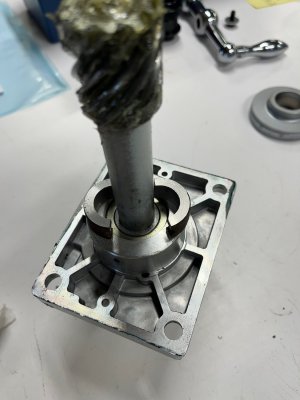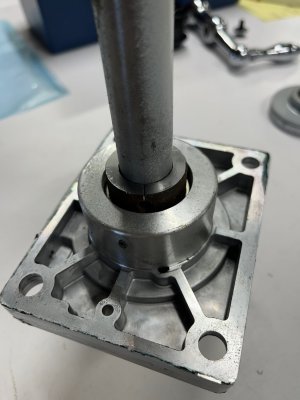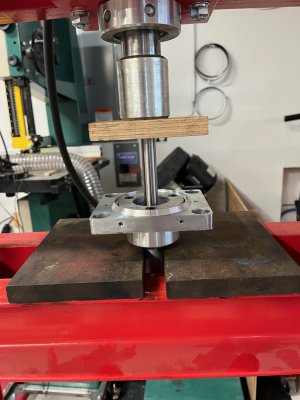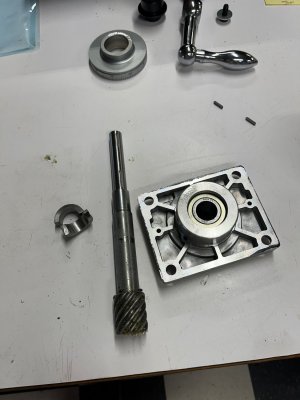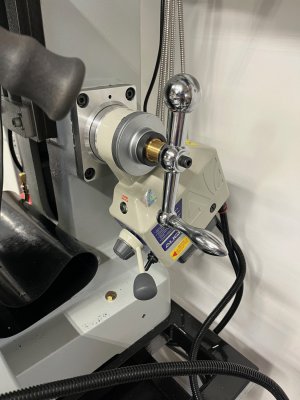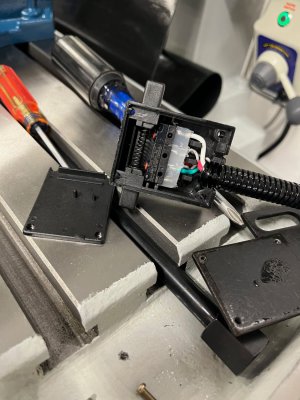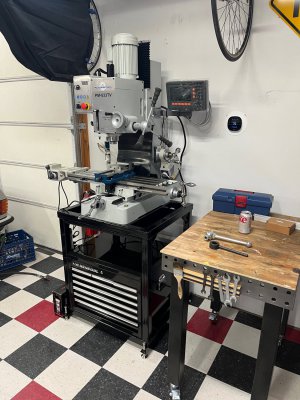The Z-axis power feed is now installed. This did not go easily. Here I’d like to highlight what I would do differently, and why, if I were to do it again. I will refer directly to the PM-833TV manual section “INSTALLING THE HEADSTOCK POWER FEED”. That document is on PM’s website here:
https://www.precisionmatthews.com/shop/pm-833tv-ultra-precision-milling-machine/
The procedure step 3 says, “Using a soft mallet, tap the gear shaft clear of the main flange.” My unit has a full-on press fit of the shaft into the bearings. Tapping would only serve to damage the bearings. I used the lathe to fabricate a split collar fitting inside the recess of the main flange supporting the inner race of the bearing while in a hydraulic press. The press got the shaft out with a few thousand pounds of pressure and a loud pop every time the shaft moved. (The image below shows a piece of plywood on the end of the shaft. That bit of wishful thinking failed with crushing of the wood. A piece of quarter-inch soft steel plate worked fine.)
Moving on:
Step 4 instructs to plug the replacement (longer) gear shaft AS FAR AS IT WILL GO into the extender. This is to be done without the main flange. Then step 5 instructs to drill for the pair of roll pins and step 6 “taps” the replacement shaft into the main flange bearings. Steps 7 and 8 install the pins.
After drilling for the first roll pin, nearest the gear, I formulated an improved procedure that did not require inserting the first roll pin, drilling for he second pin, and removing the first pin prior to putting the shaft in the bearing.
With one hole drilled, I pressed the shaft into the bearing flange. I then intended to insert the first pin and drill for the second pin with the flange in place. Then insert the second pin and be done with it. (CAUTION, my drill press vise has the height to let the flange clear the table so I can drill the assembly.)
HOWEVER: When I slipped the extender onto the shaft it would not go on far enough for the drilled holes to line up. I spent far too much time puzzling over this before mounting the extender in the lathe and facing less than 1 mm off of the end. Just enough to allow the holes to line up for pinning.
I was then able to press the first pin in. I then put the assembly in the drill press to drill the second hole. Back to the press to insert the second pin.
The second pin I found to be slightly longer than the diameter of the shaft. I filed the excess away.
STEP 12: Here we are instructed to use the SAME three M6 screws that held the inner collar to the main flange to now hold the motor mount collar. That is a “no go”. The original screws are much too short. I spent a morning chasing down three M6x25 cap screws. I cut those down to the right length. M6x20 would have worked.
In Summary, if you are doing this.
1) Plan on using a press to get the shaft out of and back in to the bearing flange.
2) If your drill press will allow. Press the new shaft in to the bearing flange. Then drill for the roll pins and insert them.
3) Get some longer screws for the motor mount collar.
My Apologies: The photographic record ceased while I was dealing with the pins.


